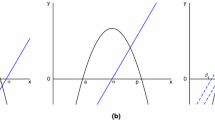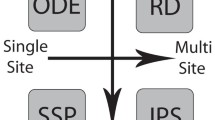Abstract
Regime shift inducibility depends on equilibrium resilience, which depends on species interactions. When species interactions include intraguild predation (IGP), integrated pest management may induce regime shifts because enhancing the abundance of intraguild predators simultaneously increases competition with, and predation on, invasive prey. To explore the dynamical consequences of such manipulations, we use a bistable, deterministic IGP model with stochastic removals that perturb invader density from the high-density equilibrium. We quantify the combined effects of IGP and such perturbations in terms of mean first passage times (MFPTs) to target invader densities such as thresholds between regimes. Analytical MFPTs compare favorably with those generated by Monte Carlo numerical solutions of the stochastically perturbed IGP model. MFPTs can therefore usefully quantify equilibrium resilience in terms of perturbation schedules.




Similar content being viewed by others
References
Bampfylde CJ, MA Lewis (2007) Biological control through intraguild predation: case studies in pest control, invasive species and range expansion. Bull Math Biol 69(3):1031–1066
Bar-Yam Y (1997) Dynamics of complex systems. Addison-Wesley, Reading
Chase JM (2003) Experimental evidence for alternative stable equilibria in a benthic pond food web. Ecol Lett 6:733–741
Claessen D, Van Oss C, de Roos AM, Persson L (2002) The impact of size-dependent predation on population dynamics and individual life history. Ecol 83(6):1660–1675
Davenport WB, Root WL (1958) An introduction to the theory of random signals and noise. McGraw-Hill, New York
De Roos AM, Persson L (2002) Size-dependent life-history traits promote catastrophic collapses of top predators. Proc Natl Acad Sci U S A 99(20):12907–12912
De Roos AM, Persson L, McCauley E (2003) The influence of size-dependent life-history traits on the structure and dynamics of populations and communities. Ecol Lett 6(5):473–487
De Roos AM, Persson L, Thieme HR (2003b) Emergent allee effects in top predators feeding on structured prey populations. Proc R Soc Lond B Biol Sci 270(1515):611–618
Dorn NJ, Mittelbach GG (1999) More than predator and prey: a review of interactions between fish and crayfish. Vie milieu Life Environ 49(4):229–237
Drury KLS (2007) Shot noise perturbations and mean first passage times between stable states. Theor Popul Biol 72:153–166
Drury KLS, Drake JM, Lodge DM, Dwyer G (2007) Immigration events dispersed in space and time: factors affecting invasion success. Ecol Model 206:63–78
Duffy-Anderson JT, Bailey K, Ciannelli L, Cury P, Belgrano A, Stenseth NC (2005) Phase transitions in marine fish recruitment processes. Ecol Complex 2:205–218
Gardiner CW (2002) Handbook of stochastic methods for physics, chemistry and the natural sciences, 2nd edn. Springer, Berlin
Holling CS (1973) Resilience and stability of ecological systems. Annu Rev Ecol Syst 4:1–23
Holt RD, Polis GA (1997) A theoretical framework for intraguild predation. Am Nat 149:745–764
Horsthemke W, Lefever R (1984) Noise-induced transitions. Theory and applications in physics, chemistry and biology. Springer, Berlin
Laio F, Porporato A, Ridolfi L, Rodriguez-Iturbe I (2001) Mean first passage times of processes driven by white shot noise. Phys Rev E 63:036105–1–8
Lodge DM, Taylor CA, Holdich DM, Skurdal J (2000) Nonindigenous crayfishes threaten north american freshwater biodiversity: lessons from Europe. Fish 25:7–20
Ludwig D, Jones DD, Holling CS (1978) Qualitative analysis of insect outbreak systems: the spruce budworm and forest. J Anim Ecol 47:315–332
Mann KH, Lazier JRN (2006) Dynamics of marine ecosystems, 3rd edn. Blackwell, Malden
Murray JD (2002) Mathematical biology. Springer, Heidelberg
Mylius SD, Klumpers K, de Roos AM, Persson L (2001) Impact of intraguild predation and stage structure on simple communities along a productivity gradient. Am Nat 158(3):259–276
Olson MH, Young BP (2003) Patterns of diet and growth in co-occurring populations of largemouth bass and smallmouth bass. Trans Am Fish Soc 132:1207–1213
Persson L, Amundsen PA, De Roos AM, Klemetsen A, Knudsen R, Primicerio R (2007) Culling prey promotes predator recovery—alternative states in a whole-lake experiment. Science 316(5832):1743–1746
Peterman RM, Pyper BJ, MacGregor BW (2003) Use of the kalman filter to reconstruct historical trends in productivity of Bristol bay sockeye salmon (Oncorhynchus nerka). Can J Fish Aquat Sci 60(7):809–824
Polis GA, Myers CA, Holt RD (1989) The ecology and evolution of intraguild predation: potential competitors that eat each other. Ann Rev Ecolog Syst 20:297–330
Press WH, Teukolsky SA, Vetterling WT, Flannery BP (2002) Numerical recipes in C++: the art of scientific computing, 2nd edn. Cambridge University Press, Cambridge
Price JE, Morin PJ (2004) Colonization history determines alternate community states in a food web of intraguild predators. Ecology 85(4):1017–1028
Revilla T (2002) Effects of intraguild predation on resource competition. J Theor Biol 214:49–62
Schröder A, Persson L, De Roos AM (2005) Direct experimental evidence for alternative stable states: a review. Oikos 110:3–19
Stein RA (1977) Selective predation, optimal foraging, and the predator-prey interaction between fish and crayfish. Ecology 58:1237–1253
Suding KN, Gross KL, Houseman GR (2004) Alternative states and positive feedbacks in restoration ecology. Trends Ecol Evol 19(1):46–53
Tang S, Xiao Y, Chen L, Cheke RA (2005) Integrated pest management models and their dynamical behavior. Math Biol 67:115–135
van de Wolfshaar KE, de Roos AM, Persson L (2006) Size-dependent interactions inhibit coexistence in intraguild predation systems with life-history omnivory. Am Nat 168(1):62–75
van Kooten T, de Roos AM, Persson L (2005) Bistability and an allee effect as emergent consequences of stage-specific predation. J Theor Biol 237(1):67–74
van Nes EH, Scheffer M (2007) Slow recovery from perturbations as a generic indicator of a nearby catastrophic shift. Am Nat 169(6):738–747
Walters C, Kitchell JF (2001) Cultivation/depensation effects on juvenile survival and recruitment: implications for the theory of fishing. Can J Fish Aquat Sci 58:39–50
Weisstein EW (2003) Generalized hypergeometric function. From mathworld—a wolfram web resource
Wills TC, Bremigan MT, Hayes DB (2004) Variable effects of habitat enhancement structures across species and habitats in Michigan reservoirs. Trans Am Fish Soc 133(2):399–411
Acknowledgements
The National Science Foundation provided financial support for this work through the ISIS project. We are grateful to Alex Potapov for help with the technical details of the single exponent approximation. We gratefully acknowledge discussions with Matt Barnes, Lindsay Chadderton, Andy Dienes, Reuben Keller, Joanna McNulty, Jody Murray, Brett Peters, and John Rothlisberger and the editorial comments of two anonymous reviewers, which clarified the manuscript.
Author information
Authors and Affiliations
Corresponding author
Electronic Supplementary Material
Below is the link to the electronic supplementary material.
Rights and permissions
About this article
Cite this article
Drury, K.L.S., Lodge, D.M. Using mean first passage times to quantify equilibrium resilience in perturbed intraguild predation systems. Theor Ecol 2, 41–51 (2009). https://doi.org/10.1007/s12080-008-0027-z
Received:
Accepted:
Published:
Issue Date:
DOI: https://doi.org/10.1007/s12080-008-0027-z




